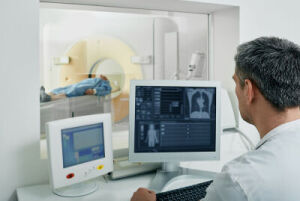by
John R. Fischer, Senior Reporter | February 06, 2024

Coronary CT angiography can identify obstructive coronary artery disease in patients better than invasive coronary angiography and other imaging modalities.
For patients with stable chest pain caused by stable angina, a coronary CT angiography (CTA) scan may be the best approach for not only ruling out obstructive coronary artery disease (CAD) but also saving them time, money, and pain they would experience if referred for invasive coronary angiography (ICA).
That’s what cardiac imaging researchers from the Atrium Health-Sanger Heart & Vascular Institute are saying in a new study presented at the American College of Cardiology Cardiovascular Summit that backs previous randomized clinical trials supporting the use of this coronary CTA.
Of 786 patients assessed for suspected angina, despite having no history of CAD, 36% underwent coronary CTA, while 44% were directly referred for ICA. Another 3% received stress echocardiogram (3%); 15%, stress myocardial perfusion imaging (15%); and 2%, stress MR imaging. From the CTA cohort, 62% were referred for ICA revascularizations to restore blood and oxygen flow in the heart, compared to 34% from those directly referred for ICA or those from the combination of other modalities.



Ad Statistics
Times Displayed: 174436
Times Visited: 3180 For those who need to move fast and expand clinical capabilities -- and would love new equipment -- the uCT 550 Advance offers a new fully configured 80-slice CT in up to 2 weeks with routine maintenance and parts and Software Upgrades for Life™ included.
As a result, the researchers say that clinically adopting a CT-first strategy should be high on the list of priorities for cardiovascular providers.
“The noninvasive approach has a lower risk and cost than a diagnostic heart catheterization and, for the CT approach — but not stress testing — provides information on the absence, presence, and extent of coronary atherosclerosis and whether or not there are high-risk plaques as well as vessel blockages, which helps streamline patient management and risk reduction,” said senior author Dr. Markus Scherer, director of cardiac CT and structural heart imaging at Atrium Health-Sanger Heart & Vascular Institute, in a statement.
Increasing adoption of this approach requires greater access to high-quality CT scanners and qualified cardiac CT interpreting physicians. Eliminating pre-established patterns established over decades such as stress testing to determine ICA eligibility is also necessary.
Additionally, clinicians need to change their views on which patients should undergo these exams. Currently, a CT-first strategy is usually only recommended for those with unestablished coronary artery disease but should be applied to all patients, say the authors. This requires evaluating and accounting for patient factors that risk reducing the accuracy and utility of coronary CTA.
One way of raising adoption, according to Scherer, is making providers aware that coronary CTA is less expensive than nuclear myocardial perfusion imaging and ICA, helping patients and third-party payers financially. This, along with its clinical benefits, makes the adoption of CT-first strategies a good way to help providers transition from fee-per-service to value-based care models.
“Cardiac catheterization labs are a capital- and human resource-intensive care environment. Using them for their maximum potential of treating disease, rather than diagnosing it, brings the highest yield for these resources to the healthcare system,” said Scherer.

